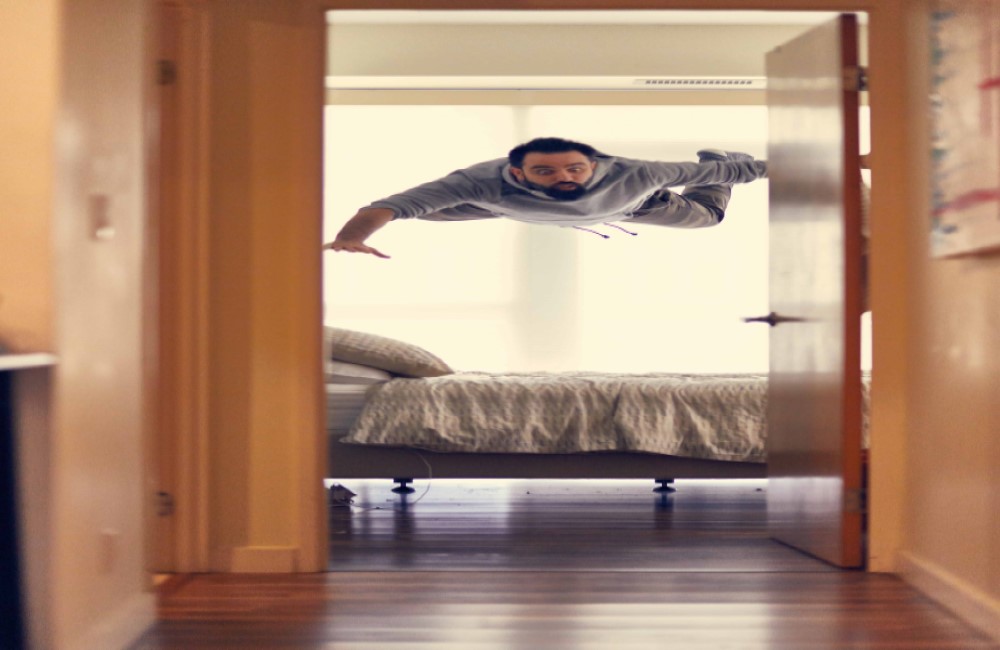There is a certain mystery involved with dreams.
You cannot predict them, and they don’t follow a specific set of rules.
I’m sure I am not the only one who was weirded out, confused or even amazed by their dreams at some point.
But what if we could control them? What if there was a way to decide what you want to dream about?
Why you should try lucid dreaming
A lucid dream is a dream in which you realize that you are dreaming, instead of believing that you are awake.
This lets you use the unique and endless opportunities a dream has to offer, to your advantage.
Because in dreams, we don’t have to adhere to laws of physics and don’t have to face the consequences of our actions, we can pretty much do whatever we want.
There are multiple ways in which you can use lucid dreaming.
Have fun with it
One way is to try and have fun with it.
Being able to fly through the sky, flirt and sleep with anyone you want, and generally spend time without responsibilities or fear of consequences can be an attractive though.
That is the reason why lucid dreaming might come in handy for you if you struggle to find leisure time.
Everyone needs to sleep, it’s one of the basic needs that is integrated into our every-day-life in a way that only a few things are.
Being able to perform whatever you want gives you the chance to feel excitement and joy, without skipping anything of your waking hours.
Use lucid dreaming to practice skills
Another reason to try lucid dreaming is that you can actually improve your real-life skillset with it.
As the study shows, people who practice flipping a coin into a cup in their dreams performed better at it when tested in real-life conditions than those who did not practice it.
This has huge implications for anyone who is interested in gaining a competitive advantage.
Imagine practicing an instrument, or getting better at specific sports.
Moreover, there are no limits for your imagination, meaning that you can improve in anything from conversational skills to learning how to skateboard.
Now obviously I’m not saying you can just pick up anything in your dream and practice it until perfection in your dreams only.
For that claim, there needs to be more scientific evidence.
However, even improving your skillset in small bits is already putting you ahead of the curve.
The Beauty of lucid dreaming
Lastly, another reason to work towards lucid dreaming is the beauty of it.
Because you can direct and influence your dreams, there are lower chances to have bad dreams, and higher chances that you dream something beautiful, something satisfying. Something that lets you get up in the morning with a good feeling about the night. Potentially improving your whole day by kickstarting it with a good vibe.
Why you should not try lucid dreaming

Despite lucid dreaming sounding awesome by the way I described it so far,
there are some downsides attached to it.
Distinguishing dreams from reality
This is probably the most common fear connected to lucid dreaming.
Once you start getting used to lucid dreaming, you might find it difficult to be as present in reality as you used to.
Anyhow, because lucid dreaming can easily be stopped, and dreams differ a lot from reality, after all, this should not cause as many troubles as you think it might.
Getting addicted
Once you start enjoying lucid dreaming in its full capacities, you could end up enjoying sleep more than reality.
Especially if you start practicing it because of a busy work-life, with many responsibilities and obligations.
Therefore, my advice is to try and focus on improving the quality of your actual life, before starting this new habit.
Whatever you decide to do, because of the ease to stop it, and it’s very harmless nature in overall, lucid dreaming can generally be seen as harmless.
Sleep paralysis
Sleep paralysis is a state in which your body is asleep, but your mind is still conscious.
This evokes a feeling of being paralyzed, unable to move at all.
Obviously, this is a very scary thought, losing your mobility would have a catastrophic influence on the lifestyle we enjoy right now.
Nevertheless, it’s important to realize that this is a rare occasion, and a temporary one as well.
Meaning that there is no real, long-term, harm inflicted.
Never waking up
When I did research for this article, I stumbled across a number of sources dealing with the fear of simply not waking up from a lucid dream.
However, there is no evidence whatsoever, that would suggest a phenomenon like that.
This fear is fueled by events that remind you of the movie Inception. Here, one of the ideas dealt with is the concept of different layers of a dream. These layers stack upon each other, creating the need to “wake up” from each consecutive dream before you are able to fully awake.
While it’s true that an experience like that is not out of the realm of possibilities, you will still wake up eventually.
In fact, lucid dreaming does not lower the chance of waking up from a dream, or in general, at all.
Should you be afraid of lucid dreaming?
Concluding, it is safe to say that lucid dreaming is very safe for your health. There are certain aspects about it that could be uncomfortable, but if you start disliking it, it is very easy to quit.
If you are interested in the concept and its possibilities, there are few reasons not to give it a shot!
How to have a lucid dream

Now that we talked about the advantages and disadvantages of lucid dreaming, let’s dive into the theory on how you can actually start to experience lucid dreaming.
Write a dream journal
One of the ways you can almost guarantee lucid dreaming in the long-run is to write a dream journal.
For this, you pick up something you can read on and place it next to your bed.
Preferably, this should be a physical notebook, something for handwriting.
As studies have shown, handwriting promotes memorizing the written content more than typing does.
This is important for our goal, which is, at first, to memorize our dreams and to save them in a sort of database.
To do this the optimal way, you have to create the habit of writing down your dreams, with as much detail as possible.
In order to achieve the best results, you should do immediately after waking up.
Since forgetting about our dreams is quickly and easily done, the best chance of catching and preserving that dream is by writing it out the moment you get conscious.
Consequently, you will get better and better at remembering the content of your dreams, the chronological order in which the events happened, and the amount of detail you can remember of those them.
Moreover, it will build up to be a nice compilation of your dreams to revisit develop.
Talking about revisiting your dreams, reading through them multiple times and trying to remember them based on what you have written down will actually speed up the result you are going to get.
Memorizing them, and ultimately mastering the number of dreams and details you can recount is the first step on the way to lucid dreaming.
Also, try to look out for patterns or unusual events in your dream journal, if you get familiar with the way your dreams are constructed, and the way they present themselves, it will get easier to realize that you are in a dream. Which helps you to take control over it.
Reality checks
A reality check is a tool that will help you to determine whether you are in a dream or not.
Since you perceive a dream just like you would perceive reality, it is actually important to have an objective measurement to tell you if you are experiencing reality or not.
The easiest choice here is to check for unrealistic depictions of reality.
One good example would be to look at your hand and count your fingers.
Often times, dreams differentiate themselves by inaccuracy. If you find yourself counting three fingers, you know that you are dreaming at that very moment.
To enforce this kind of behavior, you can make a habit out of doing it in everyday life as well.
Randomly looking down to count your fingers once in a while will make sure that similar behavior is adopted in your dreams.
Another good example is the time, or watches, to be more specific.
Creating these kinds of habits and reality checks will make sure that you are able to realize, that you are not awake.
These methods alone will already open up the possibility for lucid dreaming. However, if you are impatient and want to speed things up, there are more drastic approaches you can take.
Wake Back To Bed
The Wake Back To Bed method, also called WBTB model, is pretty straight forward.
After heading to bed, set-up an alarm clock to approximately wake you up after six hours of sleep.
When you wake up, make sure to get out of bed. Occupy your mind for about 20-60 minutes.
Try reading or meditating for this time.
Before going back to sleep, you can use affirmations and say “I will have a lucid dream now” or something similar.
If you want to read more about the power of positive affirmations and auto-suggestion, consider reading Auto-Suggestion – How to Use it.
While this is an effective method to force your way to lucid dreaming, it’s not recommended to do it over long periods of time.
Interrupting your REM sleep is not without problems, and while some practice in lucid dreaming might be beneficial, practicing to recognize dreams and perform reality checks is a more sustainable way to enable lucid dreaming.
Bottom Line
While lucid dreaming can be challenging, forcing you to step out of your comfort zone, there are many potential benefits linked to it.
If you are open minded and intrigued by ideas of this nature (which would explain why you are reading this article), I recommend giving it a shot.
Especially, because it is safe and easy to quit if you end up not liking it.
Check out The World Of Lucid Dreaming, if you want to read more about lucid dreaming!
Once you have decided to give it a shot, remember to start using a dream journal, and to practice reality checks!
For people who cannot contain their curiosity, try out the WBTB method!
Do you have any experience with lucid dreams or have any questions about it? Drop a comment!
As always, thank you so much for reading!
Cheers,
Matthis




